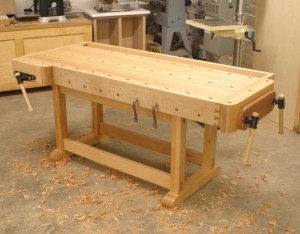Well, It’s been a busy few months so I haven’t had much time to post updates but I have some new, interesting things in the works that I wanted to share with you.
It’s been a full year since I built my first Corn Hole set. In that time, I have learned so much about basic wood working. I have had several challenges to overcome and with them some heartbreak, lots of practice of my colorful vernacular, and some surprising wins! I have built just over 60 sets which works out to:
- over 18 sheets of plywood quartered
- 120+ 6″ holes cut
- 240+ rails, stiles and legs cut
- 1680+ brad nails
- 240+ Carriage bolts, washers, and wing-nuts
- 4, 1/4″ rounder-over router bits
- 3 leg hole jigs
- 2 hole saws* 3 drills
- 2 RO Sanders
- 1 Belt sander
- An obscene about of sanding disks (80, 150, 220 grit)
Since Corn Hole sets are a very basic carcass to build, I was able to experiment with different tools and techniques to improve the quality of the product and to reduce the amount of effort to build each set. I discovered that when you compromise quality for speed, you end up paying for sooner or later.
My shop motto: Slow is fast. Fast is slow, and painful, and costly, and dangerous! I learned this when I was rushing to get the roundover on a couple sets before the rain came in. I got halfway around the the first deck when the router bit shot off at 100 MPH to embed itself in a bookcase. In my hurry, I failed to tighten the bit and rather quickly, the bit went to be with Jesus. I think about that and I could have easily joined it on that trip to the heavens or, more likely, been seriously injured.
Being self-taught, I have had a couple other minor incidents but only one requiring a trip the the clinic and that was only to make sure I was up-to-date on my tetanus shot (I just said tet-anus). But I like to think that instead of just being slow, that I am being deliberate and thoughtful. Taking this approach, I have not had any more accidents and my mistakes have diminished to level that I can blame those on the wood or the tool. 😉
Also, because of some personal events, I am not able to get into my shop until after my boys are asleep. This has vexed me considerably until I simply adopted a more focused, hand tool woodworking approach. More out of necessity, I have come to find a simple joy in working with wood and hand tools.
NOTE: Since my drill, impact driver, brad nailer, and circ saw don’t have a cord, they are considered hand tools 😉
This change has really fired up my passion for woodworking to another level. I not getting into the holy war of power vs. hand tool woodworkers. I don’t care about all that. I have a Dewalt planer and a thumb-stealing table saw, a router, etc. Power tools are cool. I use them when I have to get stuff done. However, when I need my therapy, I can either drink a bottle of rum or wander out into my shop and do some woodworking by hand. Both satisfy my need to forget the world for a time, but the benefits from woodworking outlast the rum.
With my new-found enthusiasm for wood working, I have lined up a whole host of new projects: Here are just some of them:
- Build an updated work bench (more Roubo-styled — see image above)
- Build a Sawyer’s bench (Sawing by hand is a bitch without a way to hold your work) – inspired by Tom Fidgen
- Updated Twin Screw Vise (More for joinery but this project is my white whale)
- Make and use a Frame Saw – Resawing by hand just facinates me
- Make and use a Bow Saw – i have seen some amazing things with these smaller saws and I want to see what I can make and make happen with them
- Hand Planes Extraviganza! – I recently bought Scott Meaks’ DVD on making a hand plane. It’s every bit as good as attending a class and I will dive into many of the details as I plunge into these builds. Also, I’m looking into making router planes, shoulder planes, Scratch Stocks, Rabbet Planes, Kerfing Planes, Air Planes, whatever it takes to scratch the itch
- Making Back Saws – As with many aspects of woodworking, making, sharpening, tuning and storing back saws is its own rabbit hole. I really want to explore more of this…
As you can see, building tools and appliances is really my wheelhouse since this is pretty much what I have done for the past 20 years, only with software. The tactile interaction with wood is so therapeutic for me and I appreciate every moment that I have in the shop.
Before I go, I just wanted to acknowledge a couple of people that have helped keep me motivated and inspired:
- Shannon Rogers
- Christopher Schwarz
- Tom Fidgen
- Scott Meeks
- Marc Spagnuolo
and last by certainly not least…
- Roy Underhill
(There are so many others and I will thank them when I get to projects especially inspired by them)
Thank you gentlemen for providing your knowledge, insight, and perspective to this endeavor.
For those looking for more BeagleBone Black post, I hope to be working on some robotic/electronic/music -related projects with my oldest son, and anything related in that realm, I will certainly post ASAP.



 to once logged into one of my systems. Once I am in one system, it’s easy for me to move scripts and files around but I have always struggled with the overt disconnection between my local workstation andy my network. My requirements were straightforward: Easy to configure locally, no network/remote configuration required, maintains solid security, and scriptable. Today, I made a push to get some level of resolution to this issue and I was finally successful using
to once logged into one of my systems. Once I am in one system, it’s easy for me to move scripts and files around but I have always struggled with the overt disconnection between my local workstation andy my network. My requirements were straightforward: Easy to configure locally, no network/remote configuration required, maintains solid security, and scriptable. Today, I made a push to get some level of resolution to this issue and I was finally successful using